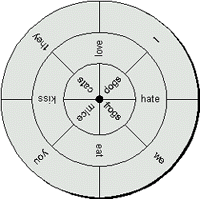1274 AD |
| Possibly the first person in the history of formal logic to use a mechanical device to generate (so-called) logical proofs was the Spanish theologian Ramon Lull (see also logic diagrams and logic machines). In 1274, Lull climbed Mount Randa in Majorca in search of spiritual sustenance. | |
| a | |
| After fasting and contemplating his navel for several days, Lull experienced what he believed to be a divine revelation, and he promptly rushed back down the mountain to pen his famous Ars Magna. This magnum opus described a number of eccentric logical techniques, but the one of which Lull was most proud (and which received the most attention) was based on concentric disks of card, wood, or metal mounted on a central axis. |  Ramon Lull's disks. |
| a | |
| Lull's idea was that each disk should contain a number of different words or symbols, which could be combined in different ways by rotating the disks. In the case of our somewhat jocular example shown above, we can achieve 4 x 4 x 4 = 64 different sentences along the lines of "I love mice," "You hate cats," and "They eat frogs." | ||
| a | ||
| Of course, Lull had a more serious purpose in mind, which was to prove the truth of everything contained within the Bible. For example, he used his disks to show that "God's mercy is infinite," "God's mercy is mysterious," "God's mercy is just," and so forth. | Lull's devices were far more complex than our simple example might
suggest, with several containing as many as sixteen different words or symbols on each
disk. His masterpiece was the figura universalis, which consisted of fourteen
concentric circles (the mind boggles at the range of combinations that could be generated
by this device). Strange as it may seem to us, Lull's followers (called Lullists) flourished in the late middle ages and the renaissance, and Lullism spread far and wide across Europe. |
|
| a | ||
| Why is all of this of interest to us? Well by some strange quirk of fate, Lull's work fired the imagination of several characters with whom we are already familiar, such as Gottfried von Leibniz who invented the mechanical calculator called the Step Reckoner. (See also Jonathan Swift and Gulliver's Travels.) | ||
| a | ||
| Although Leibniz had little regard for Lull's work in general, he believed there was a chance it could be extended to apply to formal logic. In a rare flight of fancy, Leibniz conjectured that it might be possible to create a universal algebra that could represent just about everything under the sun, including (but not limited to) moral and metaphysical truths. | In 1666, at the age of 19, Leibniz wrote his Dissertio de Arte Combinatoria, from which comes a famous quote describing the way in which he believed the world could be in the future: |
|
| a | ||
"If controversies were to arise," said Leibniz, "there would be no more need of disputation between two philosophers than between two accountants. For it would suffice to take their pencils in their hands, and say to each other: Let us calculate." |
||
| a | |
| These notes are abstracted from the book Bebop BYTES Back (An Unconventional Guide to Computers) Copyright Information |
|